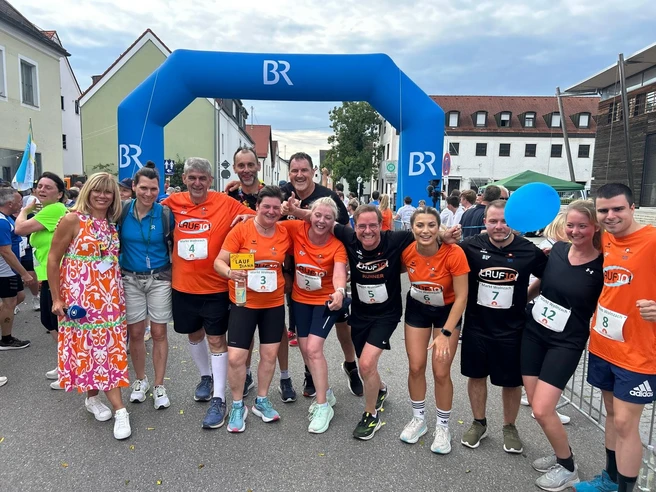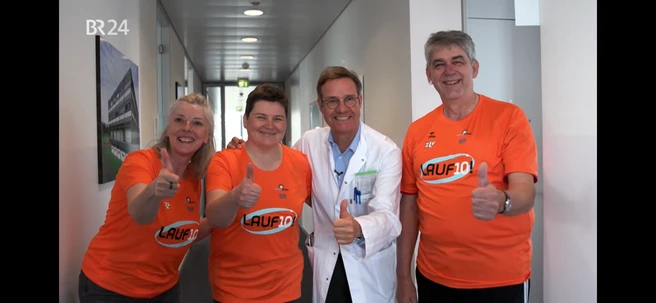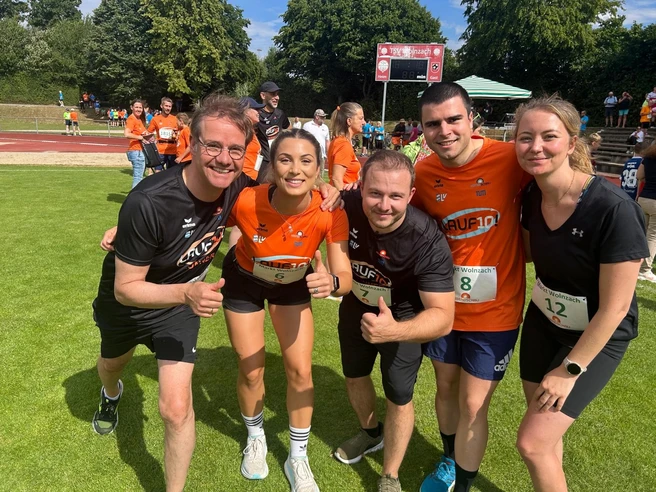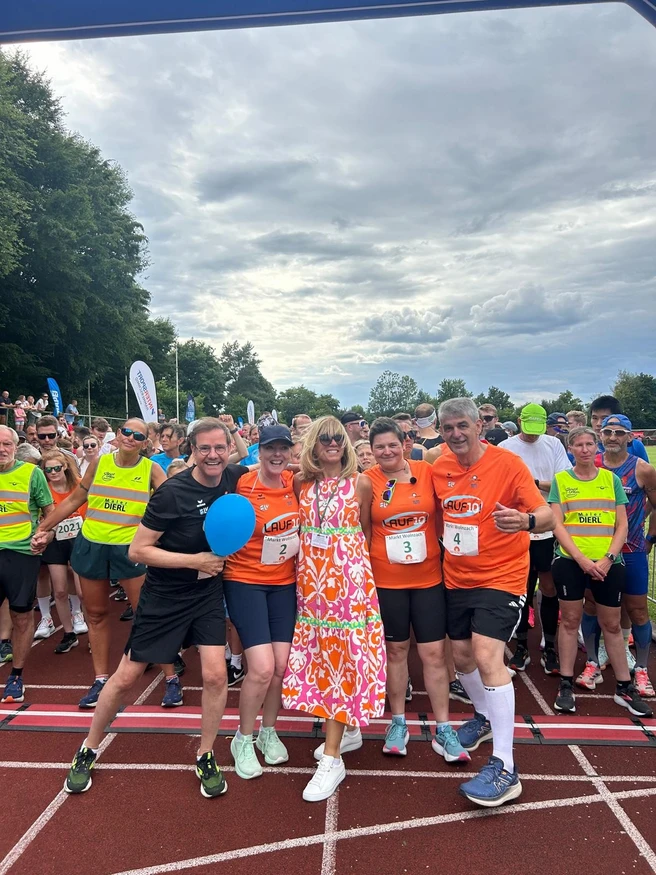LAUF10! is back! And that means: sportswear on, and off we go. Whether you're new or returning—everyone is welcome to hit the track again. The grand final run, featuring over 30,000 participants, took place on July 12 in Wolnzach—cheered on by thousands of enthusiastic spectators.
Prof. Dr. Martin Halle, head of the Chair of Preventive Sports Medicine and Sports Cardiology, guided three participants through this year’s LAUF10! program under the theme “How to get fit in 10 weeks?” The three—Diana, Michael, and Beate—came to the project with different personal challenges. Each had fallen out of regular exercise routines and developed some unhealthy eating habits. The journey began with a mandatory medical check-up.
Introducing the New LAUF10! Participants
Dancer Diana passed the initial check with no issues. Prof. Halle was pleased: “There’s a basic level of fitness—that’s not bad at all.” But he also noted concerns. Diana’s body fat percentage was 44%; a healthy range for women is typically between 20 and 30 percent. So in addition to running, strength training became part of her regimen.
Next up: Michael, a deacon weighing in at 118 kilograms. He knew what had caused the weight gain: “Carbs, bread, bread, bread—and a half-liter of beer in the evening.” The consequences showed quickly: instead of the treadmill, Michael had to switch to an ergometer for his stress test. “Too much sugar in the blood,” Prof. Halle diagnosed. “But I guarantee you this: lose ten kilos, get moving, and your blood sugar will return to normal.” For Michael, LAUF10! couldn’t have come at a better time.
Participant Beate, 59, felt out of shape, but her health check showed no medical issues. Her goal was to lose three and a half kilos before her 60th birthday and complete the 10K run. It’s a realistic aim—provided she sticks to Prof. Halle’s training plan. “Your fitness level has room to grow,” he remarked, “but I’m very confident you’ll complete LAUF10!”
Every Beginning is Hard – The Ten-Week Training Program Starts
The participants faced a structured ten-week training plan developed by Prof. Halle and his team, culminating in the big final run in Wolnzach. Extra motivation came from past participants Bernhard and Mate, who now set themselves the goal of finishing the 10K in under an hour.
After just two weeks of training, all three noticed changes in body and mind. “I miss running when I don’t do it,” said Beate. Bernhard, too, appreciated his new sense of vitality: “I can breathe better, my body responds more positively, and it just feels good.” Diana has given up her beloved sweets and has even managed to integrate and even managed to integrate the regular workouts into her workday.
Midpoint Check-In: Time to Step on the Scale Again
At the halfway mark, it was time to step on the scale again and assess progress. Prof. Halle was largely satisfied. Beate, who already had a slim build, didn’t see much change on the scale—but for her, improving fitness was the main goal. Diana had already lost three and a half kilos, and Michael had shed an impressive seven.
The next phase of the training took place on the TUM Campus at the Olympic Park running track. Here, sports scientists Emmanuel Adjei and Christian Grübel led a technique training session. After a gentle jog, the session even included short sprints. “Coordination is key,” said Adjei—just before he embarked on his heart project, Bike2MyRoots, a 10,000-kilometer cycling journey to Ghana to raise funds for educational initiatives.
From the "midpoint" check-in, things quite literally went uphill: Diana and Michael climbed Wank Mountain near Partenkirchen, guided by Christian Neureuther. Although Wank Mountain isn't a major summit, the hike was a refreshing change from their usual routine—especially for Michael, who had to go easy on his Achilles tendon. “So close to heaven,” smiled Neureuther, recalling his hikes with his late wife, Rosi Mittermaier.
Back in Munich, the final four weeks of training began—not without complications. Beate experienced pain and consulted Prof. Halle, who identified her tight flexor muscles as the cause. After just fifteen minutes of treatment, the symptoms had nearly disappeared—along with her concerns. Nonetheless, she had to ease off the training temporarily. Meanwhile, Diana and Michael completed a high-intensity session with LAUF10! Coach Paulina Jordanidis, who observed a “gigantic difference” compared to their first runs. The group even tackled the Olympic Hill—with success.
Dress Rehearsal and Final Run in Wolnzach: Will They Make It?
Next came the dress rehearsal in Wolnzach. The trio faced the course and its notorious hill with a mix of nerves and determination. Michael opted to power-walk the incline; Beate and Diana tried a steady jog. In the end, all three conquered the hill. At the summit, it was clear: a bit more training was still needed—but their progress was unmistakable.
Just before the final event, the participants underwent a comprehensive before-and-after check. The results were impressive. Michael had lost 14 kilos. “I wasn’t just disciplined—I was very disciplined,” he said about his training and nutrition. Prof. Halle praised the “incredible” improvement in physical fitness. Beate had rediscovered her joy in movement and completed the stress test with much greater ease. “Beate, you’ve made the biggest leap—an outstanding result,” commented Prof. Halle. Diana also hit her targets. “Incredible,” said the sports physician. “It’s amazing what I get to witness with LAUF10!” The three were ready for the final challenge.
The Big Day Arrives in Wolnzach
Finally, the big day arrived. Beate, Diana, and Michael warmed up like pros, posed for casual photos—though the tension in the air was palpable. Diana and Beate took a shuttle to the stadium while Michael found a quiet moment of calm.
When the starting gun fired, Michael surged forward, cheered on by the crowd, and barely slowed down. Along the way, he exchanged tips with Coach Chris Grübel and even paused for selfies with fellow runners. Beate surprised everyone by running up the feared hill without walking. Diana also surpassed expectations, finishing just behind the others. “The fact that Diana could give an interview after nine and a half kilometers says it all,” said Prof. Halle. After 1 hour and 15 minutes, it was official: all three had completed their first-ever 10K run.
It wasn’t just these three runners preparing for Wolnzach. Across Bavaria, many other training groups joined the challenge. For the first time, a running group formed at the TUM University Hospital with around 30 participants. LAUF10! was launched in 2007 by the Center for Sports Cardiology in collaboration with Bayerischer Rundfunk and the Bavarian Athletics Association (BLV) and has continued to be regularly featured in public broadcasting ever since.
To the homepage of the Chair of Preventive Sports Medicine and Sports Cardiology
To the Abendschau reports "LAUF10! - That was the 2025 season"
Contact
Prof. Dr. Martin Halle
Chair of Preventive Sports Medicine and Sports Cardiology
Am Olympiacampus 11
80809 Munich, Germany
Phone: +49 89 4140 6774 (TUM University Hospital)
Phone: +49 89 289 24441 (TUM Campus at the Olympic Park)
Email: Martin.Halle(at)mri.tum.de
Text: Bastian Daneyko
Photos: BR-Abendschau/private




